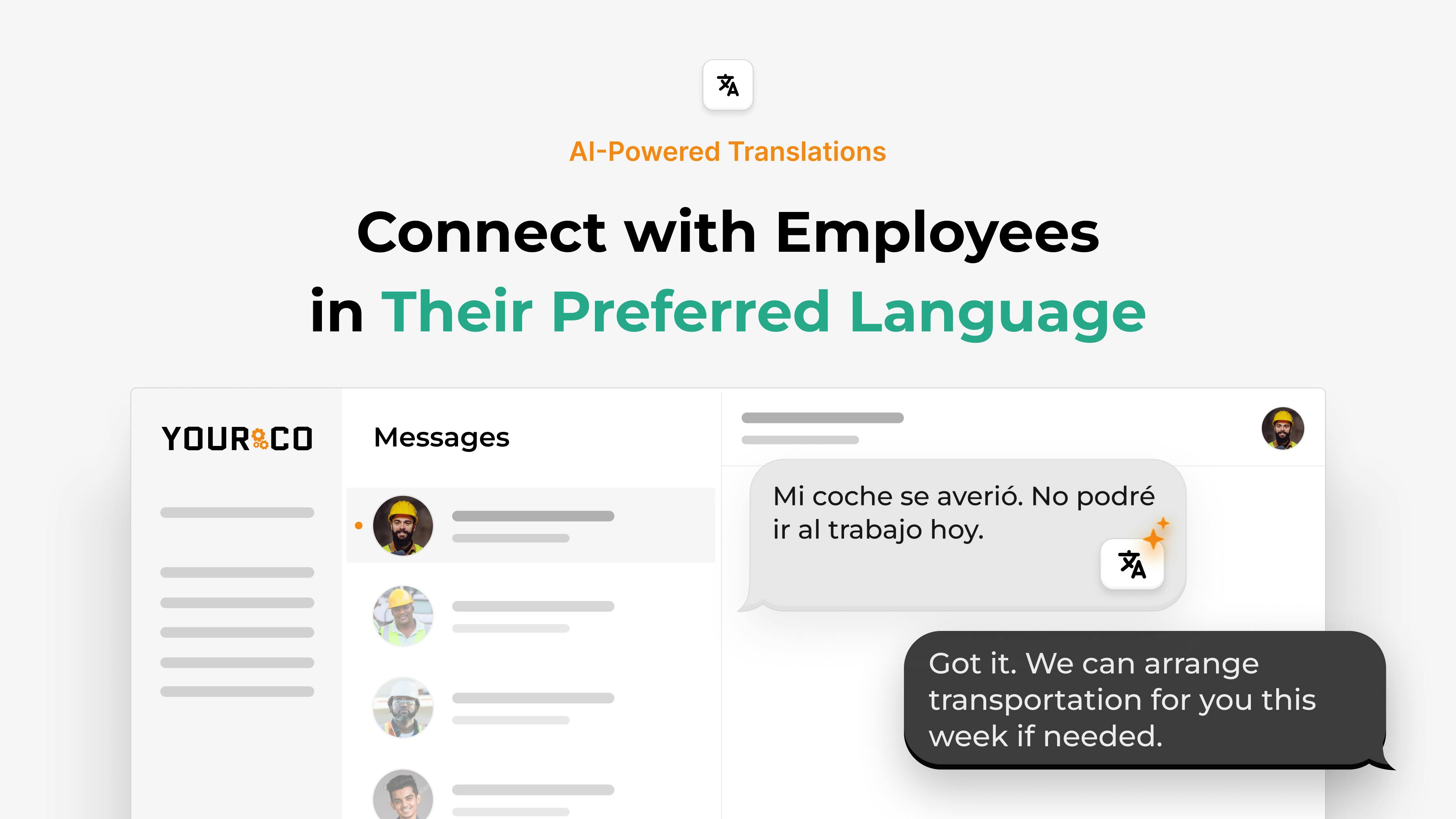How to Onboard Vietnamese-Speaking Employees: 8-Step Guide


Vietnamese-speaking employees are growing in numbers in industries such as manufacturing, logistics, hospitality, and construction. However, onboarding these team members can quickly stall when important information is delivered in the wrong language.
Without clear, job-specific guidance in Vietnamese, it's easy for confusion to set in. What’s more, cultural norms around indirect communication and deference to authority can make employees hesitant to ask for help, raising the risk of early turnover.
Add strict labor regulations, industrial compliance requirements, and shift-based worksites with limited computer access, and it becomes clear: one-size-fits-all onboarding doesn’t cut it.
This step-by-step guide shows you how to build a compliant, culturally aware, and language-friendly onboarding program from day one. Follow these eight steps, and you can expect higher retention, faster ramp-up to full productivity, and a tighter sense of belonging across mixed-language teams.
1. Confirm Compliance & Paperwork Readiness
Getting the legal foundation right from day one helps you avoid delays and confusion later. For Vietnamese-speaking employees, this means providing contracts, tax forms, and safety acknowledgments in a language they fully understand, especially when those documents carry legal weight. Clear, translated paperwork reduces misunderstandings and shows that you take both compliance and employee trust seriously.
Start with a written labor contract in Vietnamese. This isn't optional, as Vietnamese authorities require it, and the Vietnamese version takes precedence in any dispute, even if you include an English translation. Your contract must cover:
- Job duties
- Wages
- Working hours
- Probation periods
- Termination terms
While not every detail has to go into the employment contract, it's smart to include the essentials, especially when language clarity matters. Make sure each new hire receives a signed copy and understands what they’re agreeing to.
Even more important is setting up their employment profile correctly from the start. Double-check worker classification, payroll setup, emergency contact details, and any benefit enrollment forms. Missteps here, especially if someone is incorrectly treated as a contractor, can create confusion, slow down onboarding, or even risk non-compliance if you're in a regulated industry.
Here’s a quick checklist to help you get the basics right for Vietnamese-speaking employees:
- Signed contract in both English and Vietnamese
- Tax and payroll paperwork shared in both languages
- Emergency contact details
- Orientation summary and safety rules in Vietnamese
- Clear classification (employee vs. contractor) based on actual role
When paperwork is clear, classifications are correct, and your documents are language-accessible, onboarding runs smoother for both your team and your new hire.
2. Translate Core Training & SOPs
Start with the documents that keep people safe. Safety protocols, machinery instructions, and HR policies need to reach every new hire in Vietnamese before anything else.
Text-first delivery works best since an SMS link to a PDF or short video means crew members can review important steps without hunting for a computer. Tools that auto-translate messages into various languages, including Vietnamese, then send them straight to an employee's phone, remove the lag between publication and comprehension while letting you keep the English master for version control.
Always run technical translations past a native speaker who knows the equipment. A single mistranslated safety warning can cost far more than the average cost of translation services. Balance speed and accuracy by letting machine translation draft non-critical content, then reserve human review for anything tied to legal compliance, wages, or occupational hazards.
Keep a rolling translation schedule: urgent safety sheets first, followed by role-specific SOPs, then cultural or benefits material. At a minimum, make these items permanently available in Vietnamese:
- Emergency action plans
- Lock-out/tag-out procedures
- Personal protective equipment rules
- Wage and leave policies
- Team contact lists and incident report forms
Review the backlog monthly, and you'll stay ahead of new hires and regulators, without drowning in paperwork.
3. Craft a Vietnamese-Friendly Day-One Experience
With your onboarding foundation set, focus on creating first impressions that shape how quickly new hires feel safe, heard, and ready to work.
Start by building a welcome pack fully translated into Vietnamese. This can include a concise company overview, an org chart with photos, basic wage and benefits information, and safety rules. Keep it short — no more than ten printed pages — so employees can absorb the essentials without feeling overwhelmed.
For other key information, stagger delivery through scheduled SMS. A simple text 48 hours before the first day with the new hire’s start time, dress code, and site address gives people time to prepare. Yourco's scheduling feature automates those reminders, translating them into Vietnamese and 135+ other languages. This ensures every new teammate receives the same clear message regardless of their language preference or location.
On day one, follow a rhythm that alternates learning and interaction. For example:
- 9:00–9:30 – Welcome coffee with the supervisor
- 9:30–10:15 – Safety orientation and PPE fitting
- 10:15–10:30 – Break and informal Q&A
- 10:30–12:00 – Workstation tour led in Vietnamese
- 12:00–13:00 – Team lunch featuring local dishes
- 13:00–15:00 – Hands-on task shadowing
This flow respects cultural preferences for relationship-building before diving into heavy instruction. During lunch, invite senior staff to share personal career stories. Hierarchy matters in Vietnamese culture, and hearing directly from leaders signals respect.
Close the day with a short SMS linking to a feedback poll in Vietnamese. By pacing content, honoring cultural norms, and using mobile-first communication, you lay a foundation of trust that fuels engagement from day one.
4. Leverage Multilingual Communication Channels
Clear, two-way communication in a new hire's own language builds trust faster than any welcome speech. The structured day-one experience you've created needs sustainable communication systems that last well beyond orientation week. For Vietnamese-speaking employees, this means systems that automatically translate every update, shift alert, and safety reminder into Vietnamese from day one.
For non-desk teams, SMS often beats most employee communication apps by reaching workers on factory floors, construction sites, or delivery routes within seconds, driving faster responses and higher safety compliance.
Yourco's AI-powered translation engine instantly translates an English message into Vietnamese without extra work for you. SMS delivery means each worker receives the message on the phone already in their pocket — no apps, log-ins, or data plans required.
Set-up is straightforward:
- Upload Employee Directory - Employees can be added via CSV bulk upload or entered manually on Yourco platform. API integrations are also available for over 240+ HRIS and payroll systems.
- Assign Language Preferences - Each employee’s preferred language should be tagged within the Yourco employee directory.
- Define and communicate response SLAs (for example, "urgent safety texts answered within 15 minutes") and share them with supervisors.
- Schedule recurring broadcasts for things such as daily communications, policy refreshers, and training links, in both languages to reinforce key points.
- Review dashboard analytics to confirm delivery rates and response rates.
Equip managers with short training sessions on phrasing messages for translation: keep sentences brief, skip idioms, and spell out acronyms. Maintain a quick-dial list of bilingual staff for sensitive conversations that demand human nuance. Before each campaign, have a native Vietnamese speaker review templates to catch cultural missteps and ensure the tone feels respectful.
5. Assign a Bilingual Buddy or Mentor
With your multilingual communication system in place, it's time to add the human element that makes new hires truly feel supported. Pairing your new Vietnamese-speaking hire with a bilingual buddy builds confidence faster than any formal training program. A structured mentorship provides newcomers with a safe space to ask questions in Vietnamese, understand the workplace culture, and gain insight into how things really work.
In many Vietnamese workplaces, it’s considered disrespectful or uncomfortable to question authority figures directly, so new hires may hesitate to speak up around managers. A trusted peer mentor helps bridge that cultural gap, making it easier to surface concerns early and avoid silent misunderstandings down the line.
Choose a mentor who works in a similar role, shows cultural sensitivity, and communicates clearly in both languages. Proximity matters — when the buddy sits on the same line or shares shifts, guidance happens naturally during daily communications. Look for someone who already enjoys helping teammates. That genuine interest prevents the burnout that hits people who feel forced into the role.
Structure the relationship with a simple 30-60-90 day plan.
- First 30 days: Focus on daily check-ins, job shadowing, and shared lunches to build trust and comfort.
- Days 31–60: Shift to weekly skill reviews, safety walk-throughs, and gradual introductions to other team members to deepen integration.
- Days 61–90: Wrap up with a goals recap, a career-path conversation, and a short survey to confirm that the experience boosted the mentee’s employee Net Promoter Score (eNPS) by at least 15 points.
Keep in mind that recognition keeps team members engaged. A small wage bonus, a public shout-out at the shift huddle, or an extra paid day off shows that cultural integration work is valued.
Even the best program hits snags. Rotate mentors every quarter to avoid fatigue, and maintain a relief pool for peak production weeks when schedules clash. When a buddy system is intentional, resourced, and celebrated, your Vietnamese hires gain confidence while the whole team strengthens cross-cultural skills.
6. Foster Cultural Integration & Team Connection
Beyond translating materials, creating a genuine cultural connection ensures that your Vietnamese employees not only understand the work but also feel like they belong. Start cultural integration early and watch morale improve before the first payroll clears.
A simple "Vietnam 101" lunch session featuring 45 minutes of bánh mì, workplace norms around hierarchy, and tips on indirect communication helps your English-speaking managers avoid missteps and makes new hires feel valued. Structured orientation sessions led by senior leaders build respect for hierarchy and speed up trust among Vietnamese teams.
Weave Vietnamese culture into your DEI calendar instead of spotlighting it once a year. Add key holidays such as:
- Tết Nguyên Đán (Lunar New Year, late Jan / early Feb)
- Hùng Kings Commemoration Day (mid-April)
- Reunification Day (30 April) and Labour Day (1 May)
- National Day (2 September)
- Mid-Autumn Festival (late August or early September)
Post these dates in communal areas and schedule optional celebrations. This shows genuine interest.
Use quick SMS polls to learn how employees want to celebrate — home-cooked potluck or store-bought mooncakes? Short, anonymous polls respect the Vietnamese preference for indirect feedback while giving you precise planning data.
Tie each cultural touchpoint back to daily work. Invite a production-line teammate to share a five-minute story about holiday traffic safety before your peak shipping rush. When cultural activities feel relevant, engagement sticks and eNPS climbs.
Plan for misunderstandings. Encourage managers to ask clarifying questions, restate instructions, and offer private feedback channels. Proactive clarification prevents the "loss of face" that often keeps issues hidden, keeping productivity and trust intact.
7. Implement Ongoing Language Support & Development
Cultural integration and belonging set the stage for long-term growth, but language development ensures your Vietnamese employees can advance within your organization. You set new hires up for success when language help doesn't end after orientation.
Fund ESL Learning and Build a Shared Glossary
Start by funding evening ESL classes at a local center or reimbursing online coursework. Pair that with a living Vietnamese-English glossary for technical terms. In that way, employees can look up "torque wrench" or "food-grade sanitizer" in seconds. Creating a shared glossary also keeps translations consistent across your team.
Use SMS Micro-Lessons to Reinforce Learning
Schedule weekly "micro-lessons" to keep momentum. A 160-character text might introduce three safety verbs on Monday and quiz them on Friday. Because texts are compatible with every handset, uptake remains high. With Yourco, you can automate the entire cadence and link each lesson to your HRIS so new hires automatically receive their first tip at the 30-day mark.
Monitor Language Growth With Quarterly Checkpoints
Track progress just as you would wages or attendance. Short proficiency checkpoints every quarter, combined with eNPS surveys, reveal whether language confidence is climbing. When you spot a plateau, adjust the lesson mix or invite a bilingual supervisor to host a lunchtime Q&A.
By weaving steady, low-friction language boosts into daily communications and delivering them through SMS workflows, you turn language development from a one-off event into a steady engine of productivity and retention.
8. Collect Feedback & Act Swiftly
All your language development efforts remain guesswork without systematic feedback from the people experiencing your program. Hearing from new hires early and often is the fastest way to spot problems before they drive turnover. Bi-weekly pulse surveys, delivered in Vietnamese during the first 90 days, give you a real-time view of how onboarding is working while showing employees their opinions matter.
With platforms that have built-in polling, such as Yourco, you can use short SMS-based polls, allowing every worker, with or without a smartphone, to respond in under a minute. Keep surveys to five yes/no or 1-to-5 scale items, then leave one open text box for context. Focus on these kinds of questions:
- ‘’Do today's instructions feel clear enough to work safely?’’
- ‘’Do you feel you belong on your team?’’
- ‘’Are any resources or tools missing?’’
- ‘’Is your manager providing the support you need?’’
- ‘’Do you fully understand the safety rules?’’
Anonymous options encourage honesty, especially in cultures that value harmony and may avoid direct criticism. When sentiment dips on any item, trigger your escalation workflow. Supervisors review results within 24 hours, HR follows up with individual conversations within 72 hours, and fixes (such as extra training, schedule tweaks, or equipment repairs) are logged in your onboarding tracker.
Close the loop by texting a brief "You said, we did" summary every two weeks. When workers see their feedback translate into tangible improvements, such as better PPE supplies, clearer signage, and a buddy schedule that aligns with their shifts, they trust the process and remain engaged.
Turn Language Barriers into Building Blocks with Yourco
When you deliver critical information in Vietnamese via SMS, pair new hires with bilingual mentors, and actively improve your processes, you demonstrate respect for their culture and a genuine investment in their success.
Yourco's AI-powered translation and SMS-based communication system addresses the core challenges of language barriers and mobile-first workforces. Features like automated polling, translation support for over 135 languages, and real-time feedback collection turn complex communication challenges into manageable workflows.
Try Yourco for free today or schedule a demo and see the difference the right workplace communication solution can make in your company.
Frequently Asked Questions
How do I handle mixed-language teams?
Managing communication across multilingual teams can be complex but Yourco simplifies the process. Each employee can be tagged with their preferred language in the Yourco employee directory. All messages are then automatically translated. Also, during onboarding, it’s helpful to distribute a glossary of key terms (e.g., safety terms, shift codes, operational phrases).
How do I communicate with employees who have limited digital literacy?
Stick to plain-language SMS and visual aids. Strategies that use pictures and step-by-step texts bridge literacy gaps without requiring additional devices.
How do I reach employees who only carry basic cell phones?
SMS works on any device. So even a flip phone receives critical updates and reminders.
What if each location uses a different HR platform?
Yourco syncs with multiple HRIS and payroll tools, pulling rosters and location data into one place for streamlined daily communications.



